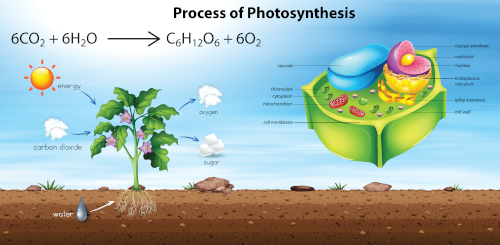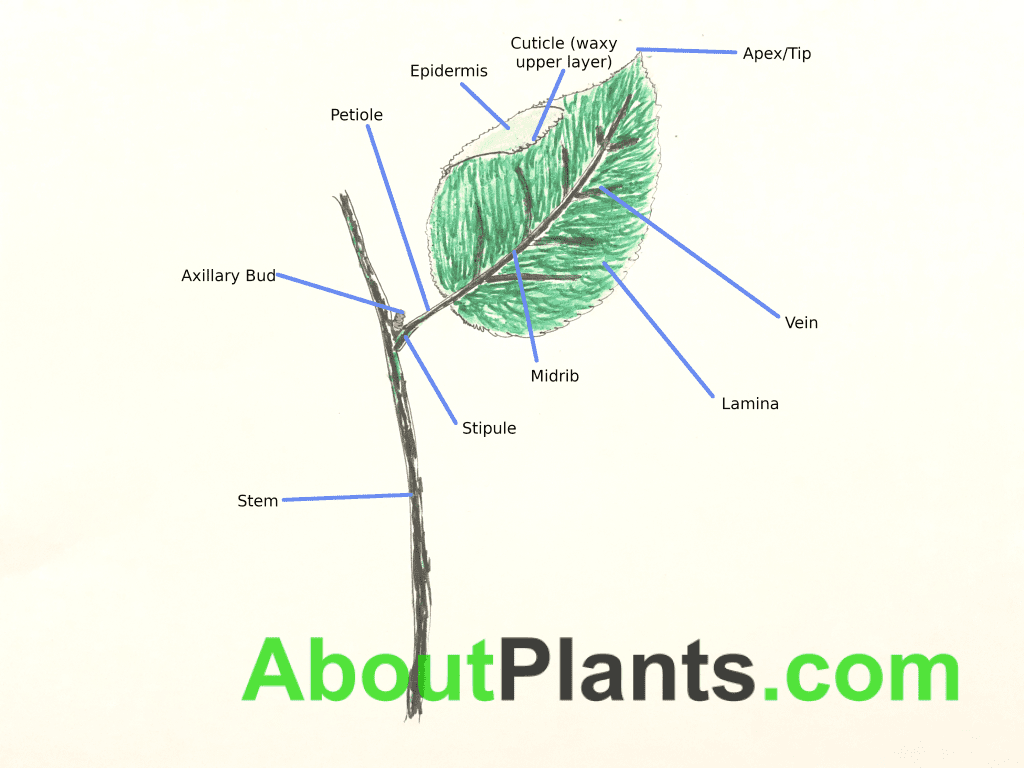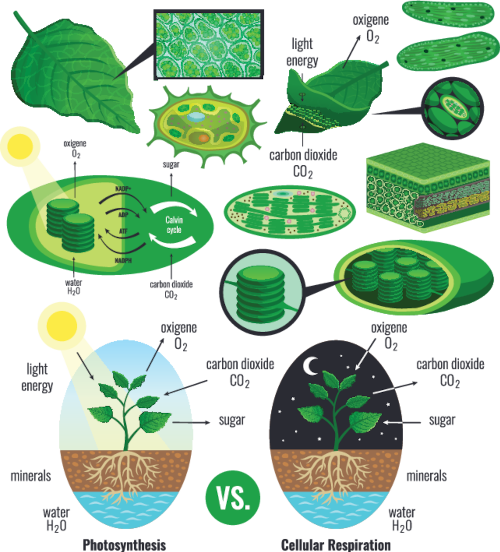Summary of Photosynthesis
Photosynthesis is a process that plants use to create their energy to survive and oxygen for the atmosphere. This process converts sunlight. Sunlight gives plants energy. The sun, like a light bulb, emits energy, which under certain conditions like those within a plant’s leaf allows this energy to be converted into food (chemical energy) for the plants to live. This is the conversion of energy from light into sugars and other compounds that the plants use to live.
In total, during daylight hours, plants use sunlight along with carbon dioxide and water to create glucose (a sugar) and oxygen through the process of photosynthesis. The three basic elements that plants need to survive are sunlight, water and believe it or not some carbon dioxide.
The process of photosynthesis where oxygen is naturally generated is one of the fundamental processes that allows life on planet earth. The production of oxygen occurs more during the day. This is because particles of light, i.e. the energy, are available during daylight and not during the night. You may realise that plants need sunlight to live because if they are covered, for example with an object on a lawn, you will notice that plants and grass and other living things fail to grow well underneath the object. You will find that after shading plants or covering them with an object they may grow quickly. This is because the plant’s natural reaction is to find sunlight. Before the sugars and nutrients that a plant has within its roots are used up, the plant will try to search for light. You will notice that the colour of grass/plants is different when shaded with an object, often the grass is a much lighter green. This is a similar process to what happens when seeds germinate and shoots quickly penetrate the top of soil layers in order to capture the sun’s energy.
At the reaction centre within the thylakoid space, the absorbed energy from light is harnessed to combine water and carbon dioxide to produce glucose and oxygen. This is photosynthesis. The photosynthesis reaction process can be summarised as:
6CO2 + 6H2O + light energy > C6H12O6 + 6O2
CO2 = carbon dioxide (each carbon dioxide molecule contains one carbon atom attached to two oxygen atoms, connected by covalent bonds).
H2O = water (each water molecule contains two hydrogen atoms connected to one oxygen atom by covalent bonds).
C6H12O6 = glucose (each glucose molecule contains six carbon atoms, 12 hydrogen atoms, and six oxygen atoms, all connected by covalent bonds).
O2 = oxygen (each oxygen molecule contains two oxygen atoms).
Glucose is made by plants and most algae during photosynthesis. Glucose is used to make cellulose in cell walls. Glucose is the most abundant sugar (a carbohydrate) in the world.
Chlorophyll
One of the principal chemicals within a plant is chlorophyll. Chlorophyll is the chemical that allows plants to harness energy from sunlight and convert it into oxygen and sugars for the plant to survive. Chlorophyll is green. The green colour of chlorophyll is what gives most plants a green appearance. The plant’s leaf contains many structures, which are discussed later in this article. One of the structures inside a plant leaf is the chloroplast. Chlorophyll resides in the chloroplasts hence where the name chloroplast comes from. Read more about chlorophyll.

The Production of Oxygen
For a reaction inside a leaf to produce oxygen, light is needed. Oxygen production lowers substantially when light is removed. During long and dark nights virtually no oxygen will be produced by the plants. However, the production of glucose for the plants to survive can continue for some time after light has been removed. This is because the Calvin cycle continues when light has been removed. The Calvin Cycle often has enough energy to continue without replenishment of light. More on the Calvin Cycle is explained later. A biologist called Melvin Calvin discovered the Calvin cycle and this is what gives it its name.
Structure of a Leaf
Basic Leaf Diagram

You may notice that a leaf has a different texture on the underside to the top. This is because the top is designed in a way to repel and disperse water so that it does not saturate the leaf.
Think about how many green leaves have a waxy appearance to aid the natural dispersion of water from the leaf onto the ground. Underneath the leaf is not waxy. This is where small holes called stomata are found. The stomata allow gaseous exchange. During daylight hours carbon dioxide enters through the stomata. Hydration can also be gained through leaves (in addition to the plant’s root system). Plants that are significantly hydrated in this way include cacti. All plants can be marginally hydrated through the leaf but plants in areas that tend to be well hydrated such as North America and the United Kingdom tend to get the majority of their hydration through their root system rather than the leaf. Water tends to be extracted from soil through the final root hairs at the tips of the root’s branches. The main trunk of the roots does not absorb as much water as the final hair-like roots that grow into the ground. The roots transfer water to the stem through small vessels known as xylem. The xylem can be thought of as tubes, which work with a capillary action to draw water up to the top of the plants and hydrate leaves so that they continue to grow and function in a normal way.
Details about Photosynthesis
Some biologists would say that photosynthesis is one of the most essential and important processes that take place. Without photosynthesis, life would not exist. Photosynthesis is essential for planets that support living organisms. Photosynthesis allows energy to be converted from light into simple carbohydrates (sugars), which sustains the growth of plant life. In turn, plants are eaten by omnivores (meat and plant eating animals) and herbivores (plant eating animals) in order for them to get sufficient nutrition and energy. This conversion of energy from light into sugars that can be consumed by other organisms can be considered the beginning of the food chain.

Photosynthesis and the Food Chain
The fact is that everything living requires energy from some source in order to live. In all mammals, which includes human beings, this is from food and drinks that contain a caloric and nutrient value. Plants use sunlight for photosynthesis. Sunlight is a high intensity stream of photons (which act like both particles and waves). Photons are direct energy that can be converted by many living things including plants. Note that energy cannot be created or destroyed but it can be converted (the first law of thermodynamics). Plants convert energy from sunlight into chemical energy. Strictly speaking, the term chemical energy does not fully describe the process but plants can use sunlight and convert energy from this sunlight into energy sources within the plant. For example, the synthesis of starches and carbohydrates. Simple sugars, such as glucose, are a form of carbohydrate and plants produce the simple sugars within their structure utilising the energy from the sun. Note that it is a common misconception that the energy within a plant is drawn from the soil.

The soil often contains the moisture and nutrients needed to allow the conversion of energy from the sun into other forms of energy (for example chemical energy in the form of simple carbohydrates and simple sugars) but essentially the soil is only a provider of nutrients and water rather than the energy that the plant can give to other living organisms. The chemical energy is stored for use later by the plants or for conversion into heat, sound and kinetic energy after it has been consumed by omnivores and herbivores. As well as omnivores and herbivores that we think of traditionally there are some creatures for example slugs and snails that consume plants in order to get their energy and nutrition. In theory, the energy used as kinetic energy for slugs and snails to move around is derived solely from sunlight, albeit following a complex group of processes that take place during the conversion of energy from sunlight into the energy needed by the slugs and snails that consume the plant.
There are some carnivores, which obviously do not eat plants usually, but yet their energy can be linked back to plants. The prey that carnivores consume in order to get their nutrition and energy needs have often consumed plants and other animals in the food chain that consume plants, and therefore there is a link back to sunlight and photosynthesis, even if it is via several steps in the transfer of energy across the planet.
Derivation of the word Photosynthesis
Photosynthesis is derived from two words, which essentially have Greek connotations for the putting together of light. The Greek for photo is light and synthesis is combination or putting together.
Essentially, during the process of photosynthesis plants absorb energy from the sun and use it in combination with carbon dioxide, nutrients from soil and water in order to produce simple carbohydrates i.e. molecules of sugar that are found inside the plant. Plants are very complex. When carbohydrates such as sugars are produced through the photosynthesis reaction comma oxygen is produced as a by-product. Therefore, we can see that plants are not only essential for life in terms of providing energy i.e. a calorific value to the kinetic movement that’s needed from all other living things but are also responsible for the creation of the atmosphere that allows living things to live. This is what separates the Earth from other planets in the solar system. If other planets could sustain life in the form of plants to the extent that the Earth can do, it is likely that animals would also be found on that planet. Who knows what is beyond our solar system?
Thank you for reading this article on AboutPlants.com. Please see the other articles including cacti, types of soil, bulbs and indoor plants. If you have any comments please contact us. If you would like to write an article or share any of your experiences, please get in touch.